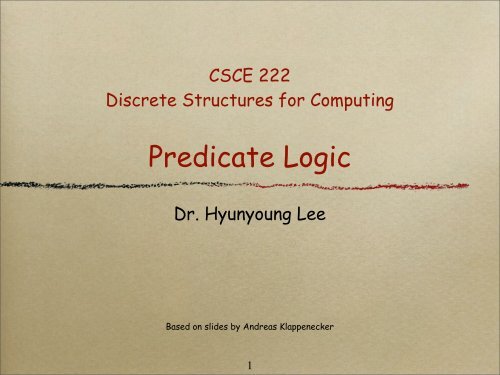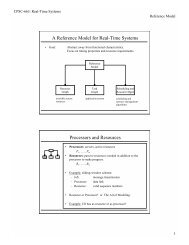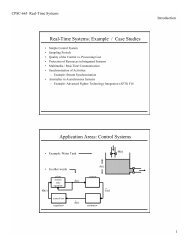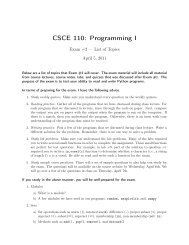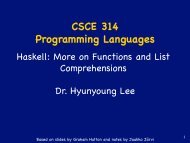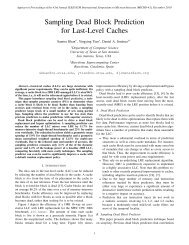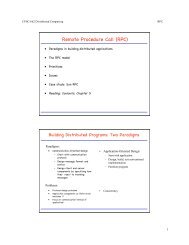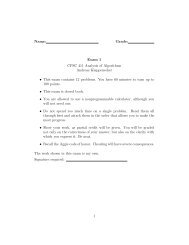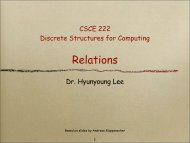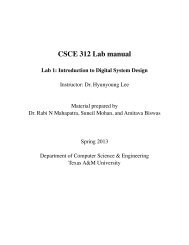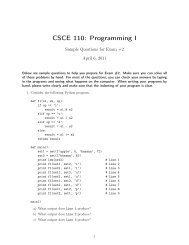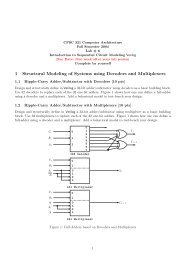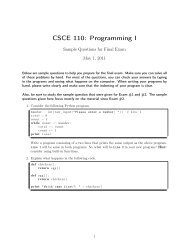Predicate Logic - TAMU Computer Science Faculty Pages
Predicate Logic - TAMU Computer Science Faculty Pages
Predicate Logic - TAMU Computer Science Faculty Pages
Create successful ePaper yourself
Turn your PDF publications into a flip-book with our unique Google optimized e-Paper software.
CSCE 222<br />
Discrete Structures for Computing<br />
<strong>Predicate</strong> <strong>Logic</strong><br />
Dr. Hyunyoung Lee<br />
Based on slides by Andreas Klappenecker<br />
1
<strong>Predicate</strong>s<br />
A function P from a set D to the set Prop of<br />
propositions is called a predicate.<br />
The set D is called the domain of P.<br />
2
Example<br />
Let D=Z be the set of integers.<br />
Let a predicate P: Z -> Prop be given by<br />
P(x) = x>3.<br />
The predicate itself is neither true or false. However, for any<br />
given integer the predicate evaluates to a truth value.<br />
For example, P(4) is true and P(2) is false<br />
3
Universal Quantifier (1)<br />
Let P be a predicate with domain D.<br />
The statement “P(x) holds for all x in D” can be written<br />
shortly as ∀xP(x).<br />
4
Universal Quantifier (2)<br />
Suppose that P(x) is a predicate over a finite domain,<br />
say D={1,2,3}. Then<br />
∀xP(x) is equivalent to P(1)⋀P(2)⋀P(3).<br />
5
Universal Quantifier (3)<br />
Let P be a predicate with domain D.<br />
∀xP(x) is true if and only if P(x) is true for all x in D.<br />
Put differently, ∀xP(x) is false if and only if P(x) is<br />
false for some x in D.<br />
6
Existential Quantifier<br />
The statement P(x) holds for some x in the domain D<br />
can be written as ∃x P(x)<br />
Example: ∃x (x>0 ⋀ x 2 = 2)<br />
is true if the domain is the real numbers<br />
but false if the domain is the rational numbers.<br />
7
<strong>Logic</strong>al Equivalence (1)<br />
Two statements involving quantifiers and predicates are<br />
logically equivalent if and only if they have the same<br />
truth values no matter which predicates are<br />
substituted into these statements and which domain is<br />
used.<br />
We write A ≡ B for logically equivalent A and B.<br />
8
<strong>Logic</strong>al Equivalence (2)<br />
∀x(P(x)⋀Q(x)) ≡ ∀xP(x) ⋀∀xQ(x)<br />
Proof: Suppose ∀x(P(x)⋀Q(x)) is true. Then for all a in<br />
the domain P(a) ⋀ Q(a) is true. Hence, both P(a) is true<br />
and Q(a) is true. Since P(a) is true for all a in the<br />
domain, ∀xP(x) is true. Since Q(a) is true for all a in<br />
the domain, ∀xQ(x) is true. Hence ∀xP(x) ⋀∀xQ(x)<br />
is true.<br />
[What else do we need to show?]<br />
9
<strong>Logic</strong>al Equivalence (3)<br />
Suppose that∀xP(x) ⋀∀xQ(x) is true.<br />
It follows that ∀xP(x) is true, and that ∀xQ(x) is true.<br />
Hence, for each element a in the domain P(a) is true,<br />
and Q(a) is true. Hence P(a)⋀Q(a) is true for each<br />
element a in the domain.<br />
Therefore, by definition, ∀x(P(x)⋀Q(x)) is true.<br />
10
De Morgan’s Laws<br />
The two versions of the de Morgan’s laws for<br />
universal and existential quantifiers are given by<br />
¬∀xP (x) ≡∃x¬P (x)<br />
¬∃xP (x) ≡∀x¬P (x)<br />
11
Example<br />
¬∀x(P (x) → Q(x)) ≡∃x(P (x) ∧¬Q(x))<br />
Proof:<br />
¬∀x(P (x) → Q(x)) ≡∃x¬(P (x) → Q(x))<br />
≡∃x¬(¬P (x) ∨ Q(x))<br />
≡∃x(¬¬P (x) ∧¬Q(x))<br />
≡∃x(P (x) ∧¬Q(x))<br />
12
Example<br />
The quantifiers can make definitions more memorable.<br />
Recall that the limit<br />
lim<br />
x→a<br />
f(x) =L<br />
is defined as: For every real number ε>0 there exists a δ>0 such<br />
that |f(x)-L|
Example (2)<br />
lim<br />
x→a<br />
f(x) =L<br />
For every real number ε>0 there exists a δ>0 such that<br />
|f(x)-L|
Example (3)<br />
What does it mean that the limit does not exist?<br />
¬∀ε∃δ∀x(0 < |x − a| < δ → |f(x) − L| < ε)<br />
≡∃ε∀δ∃x¬(0 < |x − a| < δ → |f(x) − L| < ε)<br />
≡∃ε∀δ∃x¬(¬(0 < |x − a| < δ) ∨ |f(x) − L| < ε)<br />
≡∃ε∀δ∃x(0 < |x − a| < δ ∧ |f(x) − L| ≥ ε)<br />
15
Rules of Inference<br />
16
Valid Arguments<br />
An argument in propositional logic is a sequence of propositions<br />
that end with a proposition called conclusion. The argument is<br />
called valid if the conclusion follows from the preceding<br />
statements (called premises).<br />
In other words, in a valid argument it is impossible that all<br />
premises are true but the conclusion is false.<br />
17
Example<br />
“If you have a current password, then you can log on to the<br />
network”. (p->q)<br />
“You have a current password” (p)<br />
Therefore,<br />
“You can log on to the network” (q)<br />
18
Modus Ponens<br />
The tautology (p ⋀ (p->q)) -> q is the basis for the rule of<br />
inference called “modus ponens”.<br />
p<br />
p -> q<br />
-------<br />
∴ q<br />
19
Modus Tollens<br />
¬q<br />
p -> q<br />
------<br />
∴¬ p<br />
“The University will not close on Wednesday.”<br />
“If it snows on Wednesday, then the University will close.”<br />
Therefore, “It will not snow on Wednesday”<br />
20
Simplification<br />
p ⋀ q<br />
------<br />
p<br />
21
Formal Argument<br />
Argument<br />
¬p ∧ q<br />
r → p<br />
¬r → s<br />
s → t<br />
∴ t<br />
1) ¬p ∧ q Hypothesis<br />
2) ¬p Simplification of 1)<br />
3) r → p Hypothesis<br />
4) ¬r Modus tollens using 2) and 3)<br />
5) ¬r → s Hyposthesis<br />
6) s Modus ponens using 4), 5)<br />
7) s → t Hypothesis<br />
8) t Modus ponens using 6), 7)<br />
22
Quantified Statements<br />
∀xP (x)<br />
∴ P (a)<br />
P (a) for an arbitrary a<br />
∴ ∀xP (x)<br />
∃xP (x)<br />
∴ P (a) for some a<br />
P (a) for some a<br />
∴ ∃xP (x)<br />
Universal instantiation<br />
Universal generalization<br />
Existential instantiation<br />
Existential generalization<br />
23
Universal Modus Ponens<br />
Let us combine universal instantiation and modus ponens to get<br />
the “universal modus ponens” rule of inference.<br />
∀x(P (x) → Q(x))<br />
P (a) wherea is in the domain<br />
∴ Q(a)<br />
For example, assume that “For all positive integers n, if n>4,<br />
then n 2


